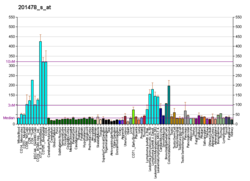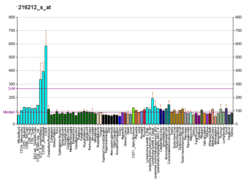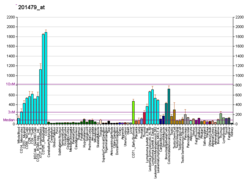Dyskerin
H/ACA ribonucleoprotein complex subunit 4 is a protein that in humans is encoded by the DKC1 gene.[5][6][7] The encoded protein, known as dyskerin, is a highly conserved nucleolar enzyme that plays key roles in rRNA modification, telomerase function, and ribosome biogenesis.
Structure
[edit]Dyskerin is an L-shaped protein consisting of approximately 514 amino acid residues, with a molecular weight of about 58 kilo-daltons.[8] It belongs to the TruB family of pseudouridine synthase enzymes and forms the catalytic core of the H/ACA box snoRNP (small nucleolar ribonucleoprotein) complex. The DKC1 gene is located on the X chromosome, in a tail-to-tail orientation with the gene encoding palmitoylated erythrocyte membrane protein 1 (MPP1), and is transcribed in a telomere-to-centromere direction.[7]
Function
[edit]The DKC1 gene encodes a core component of the H/ACA snoRNP complex, which also includes the NOLA1, NOLA2, and NOLA3 proteins. These proteins localize to the dense fibrillar components of nucleoli and to coiled (Cajal) bodies in the nucleus. The H/ACA snoRNPs catalyze pseudouridylation of rRNA and are essential for proper ribosome biogenesis. Depletion of any of the four core proteins impairs 18S rRNA production and pseudouridylation.[7]
Beyond rRNA modification, dyskerin contributes to several other fundamental processes. It stabilizes the telomerase RNA component (TERC), thereby maintaining telomerase activity and ensuring telomere elongation and genomic stability.[8] Dyskerin also participates in the assembly and maturation of ribosomal subunits by promoting correct folding and processing of pre-rRNA intermediates. In addition, it has been implicated in the regulation of pre-mRNA splicing, potentially through interactions with small Cajal body-specific RNAs (scaRNAs) that guide pseudouridylation of spliceosomal RNAs.[8]
The human protein is homologous to Saccharomyces cerevisiae Cbf5p and Drosophila melanogaster Nop60B proteins, indicating strong evolutionary conservation.[7]
Clinical significance
[edit]Mutations in DKC1 cause X-linked dyskeratosis congenita, a rare inherited disorder characterized by defective telomere maintenance, premature aging, bone marrow failure, and increased cancer susceptibility.[5][6][7] Both nucleotide substitutions and trinucleotide repeat polymorphisms have been identified in this gene. The pathogenic variants typically impair dyskerin function, disrupting rRNA modification and telomerase RNA stability, leading to the disease phenotype.
Mutations in DKC1 are also associated with Hoyeraal-Hreidarsson syndrome.[9]
References
[edit]- ^ a b c GRCh38: Ensembl release 89: ENSG00000130826 – Ensembl, May 2017
- ^ a b c GRCm38: Ensembl release 89: ENSMUSG00000031403 – Ensembl, May 2017
- ^ "Human PubMed Reference:". National Center for Biotechnology Information, U.S. National Library of Medicine.
- ^ "Mouse PubMed Reference:". National Center for Biotechnology Information, U.S. National Library of Medicine.
- ^ a b Heiss NS, Knight SW, Vulliamy TJ, Klauck SM, Wiemann S, Mason PJ, et al. (May 1998). "X-linked dyskeratosis congenita is caused by mutations in a highly conserved gene with putative nucleolar functions". Nature Genetics. 19 (1): 32–38. doi:10.1038/ng0598-32. PMID 9590285. S2CID 205342127.
- ^ a b Hassock S, Vetrie D, Giannelli F (January 1999). "Mapping and characterization of the X-linked dyskeratosis congenita (DKC) gene". Genomics. 55 (1): 21–27. doi:10.1006/geno.1998.5600. PMID 9888995.
- ^ a b c d e "Entrez Gene: DKC1 dyskeratosis congenita 1, dyskerin".
- ^ a b c Garus A, Autexier C (December 2021). "Dyskerin: an essential pseudouridine synthase with multifaceted roles in ribosome biogenesis, splicing, and telomere maintenance". RNA. 27 (12): 1441–1458. doi:10.1261/rna.078953.121. PMC 8594475. PMID 34556550.
- ^ Lim BC, Yoo SK, Lee S, Shin JY, Hwang H, Chae JH, et al. (August 2014). "Hoyeraal-Hreidarsson syndrome with a DKC1 mutation identified by whole-exome sequencing". Gene. 546 (2): 425–429. doi:10.1016/j.gene.2014.06.011. PMID 24914498.
Further reading
[edit]- Marrone A, Dokal I (December 2004). "Dyskeratosis congenita: molecular insights into telomerase function, ageing and cancer". Expert Reviews in Molecular Medicine. 6 (26): 1–23. doi:10.1017/S1462399404008671. PMID 15613268. S2CID 38163343.
- Yamaguchi H (June 2007). "Mutations of telomerase complex genes linked to bone marrow failures". Journal of Nippon Medical School = Nippon Ika Daigaku Zasshi. 74 (3): 202–209. doi:10.1272/jnms.74.202. PMID 17625368.
- Aalfs CM, van den Berg H, Barth PG, Hennekam RC (April 1995). "The Hoyeraal-Hreidarsson syndrome: the fourth case of a separate entity with prenatal growth retardation, progressive pancytopenia and cerebellar hypoplasia". European Journal of Pediatrics. 154 (4): 304–308. doi:10.1007/BF01957367. PMID 7607282. S2CID 441225.
- Maruyama K, Sugano S (January 1994). "Oligo-capping: a simple method to replace the cap structure of eukaryotic mRNAs with oligoribonucleotides". Gene. 138 (1–2): 171–174. doi:10.1016/0378-1119(94)90802-8. PMID 8125298.
- Devriendt K, Matthijs G, Legius E, Schollen E, Blockmans D, van Geet C, et al. (March 1997). "Skewed X-chromosome inactivation in female carriers of dyskeratosis congenita". American Journal of Human Genetics. 60 (3): 581–587. PMC 1712491. PMID 9042917.
- Suzuki Y, Yoshitomo-Nakagawa K, Maruyama K, Suyama A, Sugano S (October 1997). "Construction and characterization of a full length-enriched and a 5'-end-enriched cDNA library". Gene. 200 (1–2): 149–156. doi:10.1016/S0378-1119(97)00411-3. PMID 9373149.
- McGrath JA (April 1999). "Dyskeratosis congenita: new clinical and molecular insights into ribosome function". Lancet. 353 (9160): 1204–1205. doi:10.1016/S0140-6736(99)00011-2. PMID 10217077. S2CID 490860.
- Knight SW, Heiss NS, Vulliamy TJ, Greschner S, Stavrides G, Pai GS, et al. (July 1999). "X-linked dyskeratosis congenita is predominantly caused by missense mutations in the DKC1 gene". American Journal of Human Genetics. 65 (1): 50–58. doi:10.1086/302446. PMC 1378074. PMID 10364516.
- Vulliamy TJ, Knight SW, Heiss NS, Smith OP, Poustka A, Dokal I, et al. (August 1999). "Dyskeratosis congenita caused by a 3' deletion: germline and somatic mosaicism in a female carrier". Blood. 94 (4): 1254–1260. doi:10.1182/blood.V94.4.1254. PMID 10438713.
- Heiss NS, Girod A, Salowsky R, Wiemann S, Pepperkok R, Poustka A (December 1999). "Dyskerin localizes to the nucleolus and its mislocalization is unlikely to play a role in the pathogenesis of dyskeratosis congenita". Human Molecular Genetics. 8 (13): 2515–2524. doi:10.1093/hmg/8.13.2515. PMID 10556300.
- Knight SW, Heiss NS, Vulliamy TJ, Aalfs CM, McMahon C, Richmond P, et al. (November 1999). "Unexplained aplastic anaemia, immunodeficiency, and cerebellar hypoplasia (Hoyeraal-Hreidarsson syndrome) due to mutations in the dyskeratosis congenita gene, DKC1". British Journal of Haematology. 107 (2): 335–339. doi:10.1046/j.1365-2141.1999.01690.x. PMID 10583221. S2CID 23750791.
- Mitchell JR, Wood E, Collins K (December 1999). "A telomerase component is defective in the human disease dyskeratosis congenita". Nature. 402 (6761): 551–555. Bibcode:1999Natur.402..551M. doi:10.1038/990141. PMID 10591218. S2CID 4430482.
- Yaghmai R, Kimyai-Asadi A, Rostamiani K, Heiss NS, Poustka A, Eyaid W, et al. (March 2000). "Overlap of dyskeratosis congenita with the Hoyeraal-Hreidarsson syndrome". The Journal of Pediatrics. 136 (3): 390–393. doi:10.1067/mpd.2000.104295. PMID 10700698.
- Heiss NS, Bächner D, Salowsky R, Kolb A, Kioschis P, Poustka A (July 2000). "Gene structure and expression of the mouse dyskeratosis congenita gene, dkc1". Genomics. 67 (2): 153–163. doi:10.1006/geno.2000.6227. PMID 10903840.
- Pogacić V, Dragon F, Filipowicz W (December 2000). "Human H/ACA small nucleolar RNPs and telomerase share evolutionarily conserved proteins NHP2 and NOP10". Molecular and Cellular Biology. 20 (23): 9028–9040. doi:10.1128/MCB.20.23.9028-9040.2000. PMC 86556. PMID 11074001.
- Hartley JL, Temple GF, Brasch MA (November 2000). "DNA cloning using in vitro site-specific recombination". Genome Research. 10 (11): 1788–1795. doi:10.1101/gr.143000. PMC 310948. PMID 11076863.
- Simpson JC, Wellenreuther R, Poustka A, Pepperkok R, Wiemann S (September 2000). "Systematic subcellular localization of novel proteins identified by large-scale cDNA sequencing". EMBO Reports. 1 (3): 287–292. doi:10.1093/embo-reports/kvd058. PMC 1083732. PMID 11256614.
- Knight SW, Vulliamy TJ, Morgan B, Devriendt K, Mason PJ, Dokal I (April 2001). "Identification of novel DKC1 mutations in patients with dyskeratosis congenita: implications for pathophysiology and diagnosis". Human Genetics. 108 (4): 299–303. doi:10.1007/s004390100494. PMID 11379875. S2CID 23829134.






